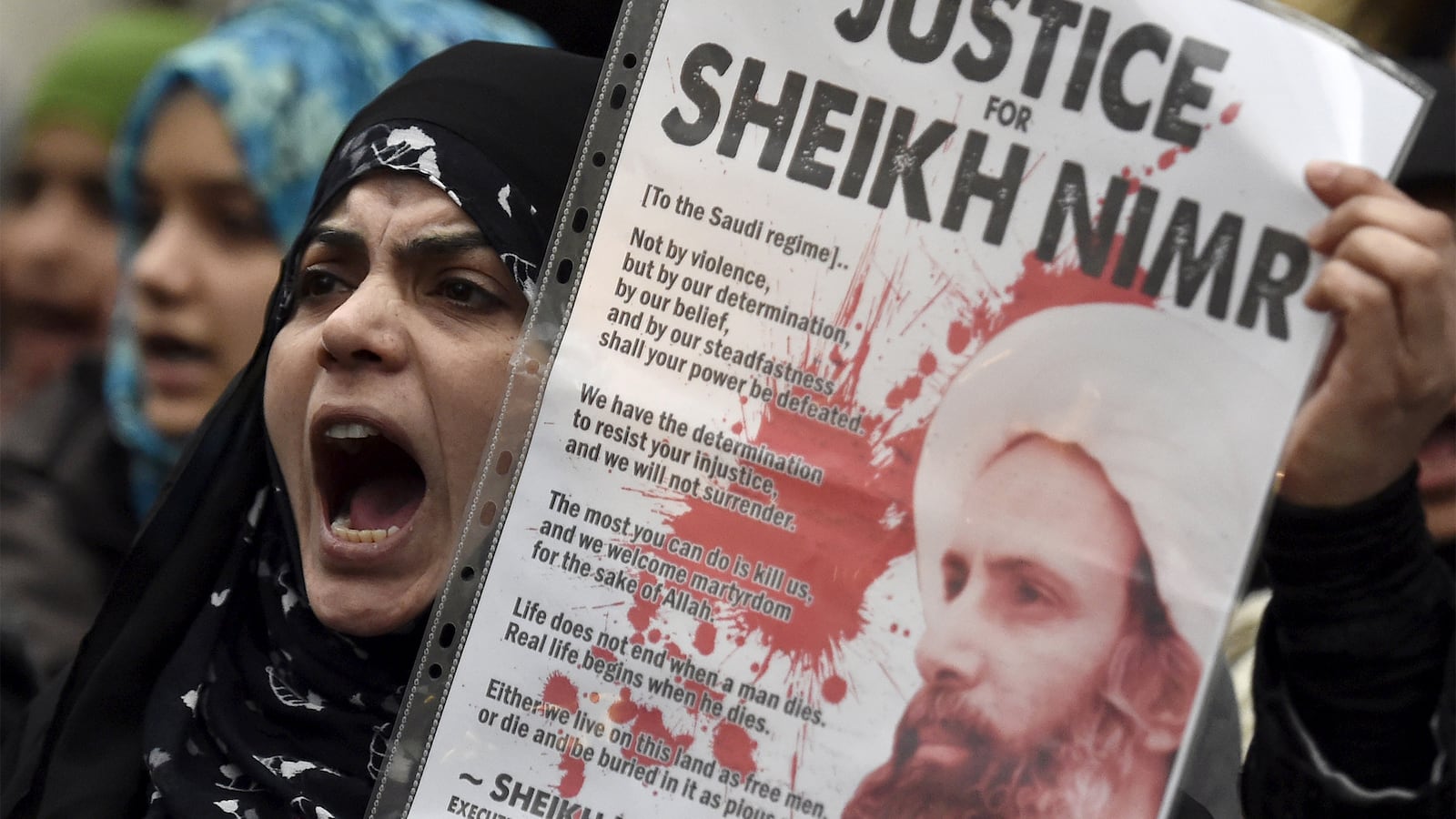Once more Saudi Arabia is executing prisoners en masse; once more Iranians are storming foreign embassies. Both countries are regressing to their basest selves. The question is: why, and perhaps more importantly, why now?
Timing is everything here. Saudi Arabia’s Jan. 2 execution of the Shia cleric Nimr al-Nimr, a Saudi national and vociferous critic of the regime, was a calculated, provocative move. Iran, the world’s premier Shia state, had repeatedly made it clear to Riyadh that al-Nimr’s death would result in grave consequences.
And so it proved. On the evening of Jan. 2, Iranian protesters stormed the Saudi embassy in Tehran and set it alight. Police looked on (clearly the storming had tacit approval from the Iranian government) before they eventually drove the protesters back. But the damage had been done. A short while later Saudi Arabia officially broke off diplomatic relations with Iran. Since them, Sunni-Shia tensions have been intensifying to even more dangerous levels.
Received wisdom says these events are merely the latest blows in a continuing Sunni-Shia sectarian battle that is cleaving the Middle East. To a degree this is correct. Ten years ago Jordan’s ruler, King Abdullah II, warned of the dangers of what he termed the “Shia Crescent”—the arc of majority or large-minority Shia communities stretching from Lebanon to Bahrain.
The center of Shia power, Jordan’s Abdullah argued, was Iran, which has since seen its influence grow dramatically following the 2003 Iraq War. Iran now pursues an unashamedly aggressive foreign policy across the Middle East, whether it is fighting wars in Syria and Yemen or trying to control the politics of Iraq and Lebanon.
Saudi Arabia, the “Sunni Lion,” which is both the richest and (with Egypt destabilized) the most powerful Sunni state in the region, has sought to counterbalance Iran in all these areas.
The Saudis are terrified of Iranian hegemony, and a few years back even urged the U.S. to "cut off the head of the snake” by striking Iran’s nuclear program. Saudi Arabia and Iran are now effectively fighting proxy wars in several theaters across the Middle East.
Since the July 14 nuclear deal between Iran and the P5+1 (the Five UN Security Council powers and Germany), which will end the international sanctions on Iran, Saudi fears of increased Iranian power have only deepened while relations with Washington have deteriorated. In Saudi eyes, President Barack Obama has chosen attempts at détente with Iran over Washington’s longstanding ties with Riyadh. The country now views itself as largely alone in the fight against Iran.
So the animosity is very real on both sides. But in truth it is often more political than religious. Both countries see themselves as natural leaders of the Islamic Middle East and geostrategic competition between the two sees each use the tropes and language of religion to cloak what are in truth political ends.
Iran is especially good at this, calling on Shia jihadis to go to Syria, ostensibly to protect the Sayyidah Zaynab shrine near Damascus, but in reality to help safeguard Syrian President Bashar al-Assad, and in so doing secure Iran’s land bridge through Syria to Hezbollah in Lebanon.
Set in this context, these latest developments become more easily understandable. That they are political is undoubted. What makes them so interesting is that this time it is domestic factors that have pushed each side to ratchet up hostilities.
Since the Iran deal, which saw Washington seemingly willing to ignore Saudi concerns regarding Iran’s nuclear program, the Saudis are feeling more isolated than they have in a long time. And the timing could not be worse. At $34 a barrel, oil prices are at their lowest since the 1990s—a serious blow to the country’s economy.
Riyadh is now facing an unprecedented $98 billion budget deficit and was recently forced to raise gas prices by 50 percent. This is dangerous for a state that keeps its population (largely) quiet by extensive state subsidies and high-paying jobs. If its ability to bribe its population effectively into quiescence is threatened, then the stability of the state itself is at risk.
Added to this, the recent ascension of King Salman to the throne has seen the kingdom introduce a new, more aggressive foreign policy, notably through military action in Yemen that has so far proved costly with little result.
With tensions at home and foreign policy failures abroad, the regime needs to make sure that its people do not become restless and do the unthinkable: start to question their leaders. What the regime needs is a distraction, and there is no better distraction that the Shia enemy—the bogeyman that is almost guaranteed to unite Sunnis both domestically and across the Middle East.
In this sense, when the Iranians allowed their people to violate all norms of diplomatic protocol by storming the Saudi embassy in Tehran, they played right into Saudi hands.
But they did so willingly. supreme leader Ali Khamenei has his own point to prove to his people, and to the watching world. And just like the Saudis, he has used al-Nimr’s execution to make it.
Khamenei had needed the nuclear deal to lift sanctions on Iran, but this need brought with it significant danger: namely, that he risked compromising the Islamic Republic’s core principle of defiance in the face of the Great Satan, the U.S.
Khamenei has to prove to the hardliners that back him that while Iran may be opening up to the global economy it will remain true to its roots. And there is no better way to show the world that the Islamic Republic remains a foe of “imperialism” than storming an embassy. The symbolism is inescapable, recalling as it does the 1979-80 Hostage Crisis when Iranian protesters stormed the U.S. Embassy in Tehran and held those inside captive for 444 days.
Allowing the Saudi embassy to be stormed has enabled Khamenei to achieve two things. One, he has increased anti-Saudi feeling in Iran—the low oil prices also drastically affect the Iranian economy, and the Mullahs can do with a distracting bogeyman of their own. Two, he has reassured his base that the Islamic Republic is not going “soft” after compromising over its nuclear program.
But while both powers are concerned with shoring up their domestic base, the latest crisis between them could not have come at a worse time for the Middle East. Last October, the Saudis and Iranians finally came together in Vienna for peace talks designed to try to end the Syrian civil war. With both countries so heavily invested in the war—Iran backs Assad and the Saudis back Sunni opposition groups determined to oust him—there is little chance of a sustainable peace without their input.
Talks are supposed to continue on Jan. 25, but since al-Nimr’s execution sectarian rhetoric from both sides has increased, and fellow Sunni Gulf states have also broken off relations with Iran. On Jan. 4, Saudi Foreign Minister Adel al-Jubeir was uncharacteristically confrontational. “We will not allow Iran to destabilize our region,” he told Reuters. “We will not allow Iran to do harm to our citizens or those of our allies, and so we will react.”
Iran-Saudi relations are at their lowest point since the late 1980s, and this enmity now threatens to derail the upcoming talks. Officials are worried. Steffan de Mistura, the UN envoy to Syria, was clear on the gravity of the situation: “We cannot afford to lose this momentum despite what is going on in the region,” he said.
Given that the two countries are already backing different horses in Syria, the latest crisis is likely to make the, admittedly distant, prospect of a solution in Syria even more remote.






